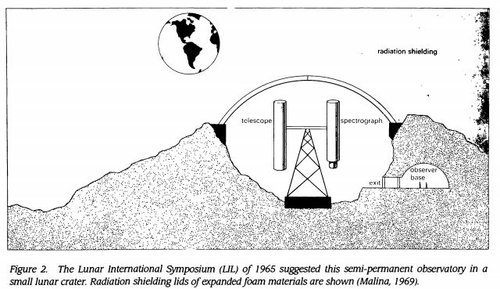- Joined
- 9 October 2009
- Messages
- 21,129
- Reaction score
- 12,215
Came across this while researching something totally different. This project was first proposed by Dr. Frank Malina (one of the founders of the Jet Propulsion Laboratory) in late 1960 as an ideal candidate for the first activity of the just formed Academy of Astronautics (now known as the International Academy of Astronautics). At least some preliminary work was done before September 1964, when during that month's meeting of the International Astronautical Federation in Warsaw, a discussion panel discussed various ideas for the project, as well as potential pros and cons (for example, could humans stay for any length of time on the Moon's surface?). Conspicuously absent from the discussion however, was any direct discussion of political, social and possible legal issues relating to Moon exploration (the venue had at least something to do with that).
It was hoped that emplacement of the laboratory could begin in 1974 (based on the progress of the US and Soviet space programs as of that time). Primary research areas were Astronomy (radio and optical though there were some concerns for the viability of the latter in Lunar conditions) and Selenology (Lunar sciences, including Lunar geology). Space Biology and related fields would have been a secondary area. The initial stage of the LIL was intended to be unmanned, with remotely operated soft landed instruments and other equipment including mobile robots, because of the perception that early long term manned surface exploration would be prohibitively expensive for an international project (as well as the aforementioned concerns about the long term health of lunar personnel). A certain Dr. Stark Draper was the key proponent of this approach. Astronomical research would have likely been the priority more or less by default during this initial period. However, it was intended for the LIL to eventually become at least a semi-permanently manned facility once immediate health concerns, as well as lower logistic costs, were satisfied. A design for a large 'Lunar igloo' by the Soviet architect S. V. Forlov was displayed at the meeting as a proposed habitat for this stage of the project. It would have been able to house up to 20 personnel.
I have been trying to find artist impressions, drawings, and other documentation on the project, but so far no luck. A brief mention of the project can be found in the September 17th, 1964 edition of the New Scientist.
It was hoped that emplacement of the laboratory could begin in 1974 (based on the progress of the US and Soviet space programs as of that time). Primary research areas were Astronomy (radio and optical though there were some concerns for the viability of the latter in Lunar conditions) and Selenology (Lunar sciences, including Lunar geology). Space Biology and related fields would have been a secondary area. The initial stage of the LIL was intended to be unmanned, with remotely operated soft landed instruments and other equipment including mobile robots, because of the perception that early long term manned surface exploration would be prohibitively expensive for an international project (as well as the aforementioned concerns about the long term health of lunar personnel). A certain Dr. Stark Draper was the key proponent of this approach. Astronomical research would have likely been the priority more or less by default during this initial period. However, it was intended for the LIL to eventually become at least a semi-permanently manned facility once immediate health concerns, as well as lower logistic costs, were satisfied. A design for a large 'Lunar igloo' by the Soviet architect S. V. Forlov was displayed at the meeting as a proposed habitat for this stage of the project. It would have been able to house up to 20 personnel.
I have been trying to find artist impressions, drawings, and other documentation on the project, but so far no luck. A brief mention of the project can be found in the September 17th, 1964 edition of the New Scientist.
Last edited:


